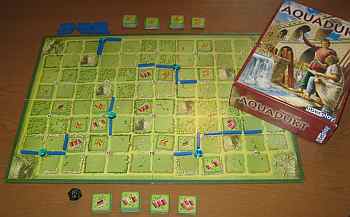Stake Your Claims around an Aquadukt
Water always flows downhill, and Aquadukt makes no exception to this rule. A game like Boggle uses 16 letter dice, but Aquadukt uses one die with 20 sides – one for each field on the board.
 In Aquadukt, you get a set of tiles that show from 1 to 4 buildings each. If you can “water” more of those buildings than your opponents, you win. To “water” your buildings, they must be close enough to an aquadukt (aquaduct; that is, blue wooden sticks) which are laid between fields.
In Aquadukt, you get a set of tiles that show from 1 to 4 buildings each. If you can “water” more of those buildings than your opponents, you win. To “water” your buildings, they must be close enough to an aquadukt (aquaduct; that is, blue wooden sticks) which are laid between fields.
To place a tile on the board, you roll the 20d, decide which tile you want to place and set it in an open square within that numbered field. When all the squares in a field are filled – either with building tiles or mountain tiles – any unwatered tiles are removed from the game. (Mountain tiles, which were randomly placed during setup, remain until the end of the game.)
Aquadukt ends when the last water stick is placed. You then remove any unwatered building tiles and count the buildings on those that did get watered. The player with the highest total wins.
What Strategy Is There in Aquadukt?
Your main choice in Aquadukt is to decide which of your four values of tiles to place in a field. Do you place a high-count tile with four buildings, hoping it will eventually get watered? Do you use one of your low-count tiles with one building to get rid of them more quickly? If there is an opportunity to place a tile on a spot that is already watered, you must use your lowest value tile. Thus it’s advantageous to have only high-count tiles available at such a time.
You also have to decide when to defer rolling the die to place either a well or some canals. Judicious placement of these items can make or break your game.
Wells must be dug at least five squares away from any other well already on the board. That limits where you can dig, especially later in the game.
Steering your canals away from your opponents’ buildings can sometimes make it impossible for theirs to be watered before the end of the game. This is a nasty but often necessary trick.
After learning which numbered field you can lay a tile in, you usually have to decide which square to actually put it on. Fields have varying amounts of squares, which can be modified by the mountains randomly placed at the beginning of the game. Do you put your tile adjacent to a tile already on the board, or do you stay away from it?
If there’s only one square left in the field and it’s not currently watered, dropping your buildings there will “fill and kill” it. When a field is full of tiles, any not watered are discarded from the game. You might do this on purpose if it will hurt your opponents or if you want to continue rolling the die on your current turn.
Do I Like Aquadukt?
Yes, I like this game. It’s simple enough to teach easily yet has enough choices to make it interesting.
About the only thing I wish were different is the game board itself. As you can see above, it’s all greens in slightly different shades. I understand that these are fields, but not all fields are green. It would be nice to have a few yellows and browns to help distinguish one field from another. The mountains too are greenish. They could easily have been more brown or gray like rock.
If you like games with tiles, check out my review of 4th Corner.
Check the price of Aquadukt on Amazon.

Pingback:Time for a Review Review | Fun Board Games